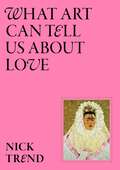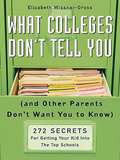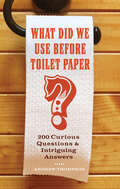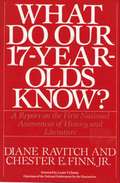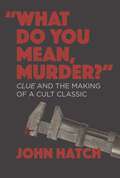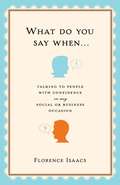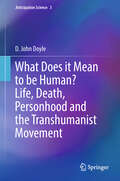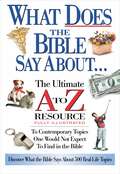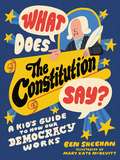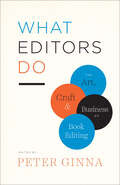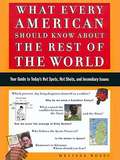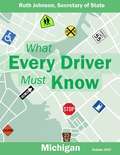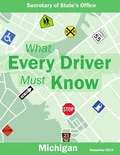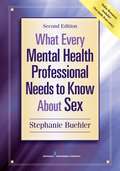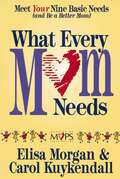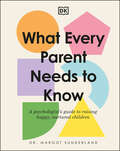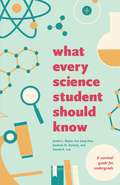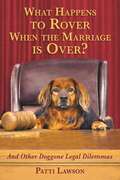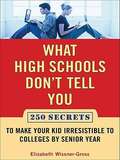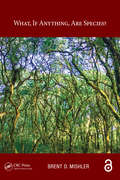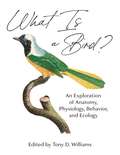- Table View
- List View
What Art Can Tell Us About Love
by Nick TrendDiscover the love affairs that inspired art's greatest masterpieces. Whether in the throes of passion, enduring the pain of an unrequited love or basking in the joy of a wonderfully supportive friendship, this book explores how love influenced artists and the work they created.Beautifully illustrated with full-colour photographs of more than 70 artworks, this guide looks at how artists have painted, sketched and modelled their lovers, and how the theme of love has found its way into an array of subjects - from landscapes to still-life and self-portraits.Artists include: Caravaggio, Georgia O'Keefe, Sarah Bernhardt, Picasso, Rembrandt, Frida Kahlo, Tamara de Lempicka, Clifford Prince-King, Chagall, Lotte Laserstein and Niki de Saint Phalle.
What Colleges Don't Tell You
by Elizabeth Wissner-GrossFrom the author of What Colleges Don't Tell You, 250 secrets for raising the kid colleges will compete to acceptThe headlines prove it: Competition for admission to America's top colleges is more cutthroat than ever. Gone are the days when parents could afford to let high school guidance counselors handle the admissions process alone-gone, also, are the days when a student could wait until senior year to prepare for it. As Elizabeth Wissner-Gross, a highly successful educational strategist, knows from working for over a decade with hundreds of middle- and high school students and their parents, if you want to raise a kid colleges will compete for, you must act, early and aggressively, as opportunity scout, coach, tutor, manager, and publicist-or be willing to watch that acceptance letter go to someone whose parents did. What High Schools Don't Tell You reveals 250 strategies to help parents stack the admissions deck in their kid's favor, gleaned from Wissner-Gross's expertise and from interviews with parents of outstandingly high achievers-strategies that most high school guidance counselors, principals, and teachers simply don't know to share. From identifying exactly which academic credentials will wow an admissions committee to which summer programs and extra-curriculars can turn an ordinary applicant into a must-have, What High Schools Don't Tell You demonstrates how hands-on parental involvement early in a child's high school career is essential to achieving college admissions success.
What Did We Use Before Toilet Paper?: 200 Curious Questions & Intriguing Answers (Fascinating Bathroom Readers)
by Andrew ThompsonAnswers to the questions that keep you up at night—from Why is bellybutton lint generally blue? to Why does catnip affect cats?BAFFLING AND BIZARRE.ENTERTAINING AND ENLIGHTENING.This witty and compulsive collection of trivia will captivate and surprise you with its fun and funky revelations. You’ll learn . . . Why New York is called “the Big Apple”How people count cards at casinosWhat keeps the head on a glass of beerWhy you never see baby pigeonsWhy getting married is called tying the knotPraise for Andrew Thompson and his popular trivia books“A very handy book that could honestly, save their life—or just answer all those questions they’re maybe too embarrassed to even google.” —Buzzfeed
What Do I Do If...?: How to Get Out of Real-Life Worst-Case Scenarios
by Eric GrzymkowskiEasy solutions for life's toughest scenariosWhen there's a 1 in 12 million chance of a shark attack occurring and a 1 in 5 chance of bed-bug infestation, it's easy to see which scenario is worth preparing for. What Do I Do If...? helps you solve the far more common, but no less devastating, of life's little curveballs. From accidentally dropping your ring down the drain to blowing out a tire at 65 mph to dealing with a friend who won't pay you back, each entry offers practical advice for fixing or getting out of just about any situation. With these handy instructions, you'll finally be able to breathe a sigh of relief when your boss comes onto you, your brakes fail, or you get trapped in an avalanche.Filled with 120 valuable solutions to life's toughest problems, this book is there to save the day when you run into some bad luck and have no idea what to do next.
What Do Our 17-Year-Olds Know
by Diane RavitchWhat Do Our 17-Year-Olds Know? Gives the results of the first nationwide test of American high school students' knowledge of history and literature, as well as fascinating insight into what teenagers are reading, how much television they watch, what influence their home environment has on their academic achievement, and what historical topics and literary works are included in (or have been dropped from) the school curriculum.
What Do you Mean, Murder?: Clue And The Making Of A Cult Classic
by John HatchUnlock the mystery behind the making of the 1985 cult-classic Clue, with details on the beloved film from author John Hatch, who offers plenty to chew on for die-hard buffs and casual fans alike, plus new insights from writer-director Jonathan Lynn and actress Colleen Camp.When the film Clue came out in 1985, audiences were baffled. A movie based on a board game, with three different endings, and you had to pick which one to go see? Bad reviews compounded the problem, and instead of choosing one ending, most people stayed away entirely. Clue, outgrossed at the box office by films that had been released months earlier, quickly faded away. When it unceremoniously premiered on Showtime a year after its theatrical debut, there was no sign it was destined for anything other than obscurity, another flop bound to be forgotten. Instead, Gen Xers and millennials, raised on pop culture and cable TV in an era long before the streaming wars, discovered this zany farce about a group of six strangers locked in a remote house with a killer. The movie appealed to kids. The creepy mansion and eerie music contrasted with slapstick gags and double entendres, deflating the tension. Today, almost forty years later, Clue is the epitome of a cult classic, with midnight screenings, script readings for charity, cosplaying fans, and a stage play. "What Do You Mean, Murder?&” dives deep into the making of Clue and walks fans through the movie they know and love. From producer Debra Hill&’s original idea of Detective Parker bumbling around a mansion to Carrie Fisher&’s casting as Miss Scarlet, from Madeline Kahn&’s iconic &“flames&” ad-lib to the legendary deleted fourth ending, it&’s all here. With asides on fandom, Gen X nostalgia, and at how movies were made in the 1980s, the book offers plenty to chew on for die-hard buffs and casual fans alike.
What Do You Say When . . .: Talking to People with Confidence on Any Social or Business Occasion
by Florence IsaacsHave you ever walked alone into a room of chattering people and felt nervous? Is the idea of attending a wedding or job interview where you won't know many people intimidating? The art of conversation is a necessary skill for navigating life’s social and business occasions, and with practice you can develop the ability to easily talk to people. What Do You Say When ... is a smart, useful tool that helps you assess all situations and approach people with confidence.When you can chat easily and know the right things to say, you not only feel more relaxed, but also make others feel comfortable. What Do You Say When ... provides a complete guide to conversation in a variety of circumstances. It teaches the basics, plus helpful rules that work anywhere and with anyone—at cocktail parties, dinners, charity benefits, job interviews, conferences and conventions, dates, and even at family reunions and other gatherings. Also covered are can’t-fail conversation openers and strategies for expanding conversation and getting to know casual social or business contacts better. You’ll learn how to find appropriate words for difficult times, such as a friend’s divorce, illness, or job loss, or when someone’s loved one has died. Included, too, are tips on teaching your children to converse politely.Filled with examples, ideas, and practical advice, What Do You Say When ... helps you master one of life’s most essential skills.
What Does it Mean to be Human? Life, Death, Personhood and the Transhumanist Movement (Anticipation Science #3)
by D. John DoyleThis book is a critical examination of the philosophical and moral issues in relation to human enhancement and the various related medical developments that are now rapidly moving from the laboratory into the clinical realm. In the book, the author critically examines technologies such as genetic engineering, neural implants, pharmacologic enhancement, and cryonic suspension from transhumanist and bioconservative positions, focusing primarily on moral issues and what it means to be a human in a setting where technological interventions sometimes impact strongly on our humanity. The author also introduces the notion that death is a process rather than an event, as well as identifies philosophical and clinical limitations in the contemporary determination of brain death as a precursor to organ procurement for transplantation. The discussion on what exactly it means to be dead is later applied to explore philosophical and clinical issues germane to the cryonics movement. Written by a physician/ scientist and heavily referenced to the peer-reviewed medical and scientific literature, the book is aimed at advanced students and academics but should be readable by any intelligent reader willing to carry out some side-reading. No prior knowledge of moral philosophy is assumed, as the various key approaches to moral philosophy are outlined early in the book.
What Does the Bible Say About...: The Ultimate A To Z Resource (A to Z Series)
by Thomas NelsonHave you ever wondered: what does the Bible have to say about___? Now you fill in the blank. This Ultimate A to Z Resource applies biblical insight to hundreds of contemporary topics ranging from:AddictionPolitical infightingWorld hungerBirth controlFreewillDysfunctional familiesPrejudiceand Natural disastersIn this handy, portable index, you can easily locate any topic—from the broad (conflict resolution, anxiety, and companionship), to the very specific (contracts, debt, and pornography). Each entry contains a summary of the topic, theological/biblical considerations, and verse references to point you directly to the larger scriptural context.The Bible may be 2,000 years old, but it has relevant and wise words on just about any subject, ancient or modern—it is the Living Word of God, and this quick guide is one great way to familiarize yourself with its contents...one topic at a time.Also contains illustrations from Christian cartoonist Jonny Hawkins.
What Does the Constitution Say?: A Kid's Guide to How Our Democracy Works
by Ben SheehanIf you've never read the Constitution, let this guidebook help you! Featuring fun facts, cool illustrations, and even hilarious jokes, What Does the Constitution Say? will help you understand how our American government really works. Written more than 230 years ago, the Constitution can be hard to understand (even for adults). But it also gives you what you need to make our country the best it can be for everyone. What Does the Constitution Say? takes you on a tour of the whole Constitution while explaining what its fancy words really mean. From the Preamble to the 7 Articles to the 27 Amendments (so far), this fun-to-read guide is packed with bite-sized info, historic quotes, and graphics on important topics such as:Why the Constitution is a "living document"How the first attempt at a constitution (the Articles of Confederation) failedWhat powers the president does (and doesn't) haveKey figures like James Madison, Alexander Hamilton, and George WashingtonA bonus section on the Declaration of IndependenceAnd much more!
What Does the Earth Sound Like?: 159 Astounding Science Quizzes
by Eva EverythingAn all-ages quiz book that makes learning science fun, from the Discovery Channel science quizmaster and author of What Does the Moon Smell Like? From the surprising science behind everyday life to the mysteries on the frontiers of scientific discovery, this quiz book explores anything and everything in a fun, user-friendly format. Topics include the Earth, the moon, and the stars; satellites and space travel; pets and other animals; nature and the environment; the brain and the body; and the psychology of food, behavior, success, and attraction. The introductions to each question are peppered with interesting tidbits of information, and the fascinating answers to these quiz questions are explained in detail and given full context. Whether used as an individual brain workout or as a fun game at social gatherings, What Does the Earth Sound Like? is smile-inducing and thought-provoking. &“Playful questions like those in What Does the Earth Sound Like? can provide important insights and understanding . . . Delightful.&” —Marty Hoffert, professor emeritus of physics, New York University Praise for What Does the Moon Smell Like? &“This is a great book. It became a popular table game in the summer holidays with two teams competing with all the questions. It makes an excellent change from celebrity trivia.&” —Peter Gabriel, Rock & Roll Hall of Famer &“Proving that science can be wildly fun with each new page, this book reads like a mad scientist&’s Trivial Pursuit . . . A book that will surely provide hours of thought-provoking and amusing entertainment.&” —Scene Magazine
What Editors Do: The Art, Craft, and Business of Book Editing (Chicago Guides to Writing, Editing, and Publishing)
by Peter GinnaEditing is an invisible art where the very best work goes undetected. Editors strive to create books that are enlightening, seamless, and pleasurable to read, all while giving credit to the author. This makes it all the more difficult to truly understand the range of roles they inhabit while shepherding a project from concept to publication. In What Editors Do, Peter Ginna gathers essays from twenty-seven leading figures in book publishing about their work. Representing both large houses and small, and encompassing trade, textbook, academic, and children’s publishing, the contributors make the case for why editing remains a vital function to writers—and readers—everywhere. Ironically for an industry built on words, there has been a scarcity of written guidance on how to actually approach the work of editing. This book will serve as a compendium of professional advice and will be a resource both for those entering the profession (or already in it) and for those outside publishing who seek an understanding of it. It sheds light on how editors acquire books, what constitutes a strong author-editor relationship, and the editor’s vital role at each stage of the publishing process—a role that extends far beyond marking up the author’s text. This collection treats editing as both art and craft, and also as a career. It explores how editors balance passion against the economic realities of publishing. What Editors Do shows why, in the face of a rapidly changing publishing landscape, editors are more important than ever.
What Every American Should Know About the Rest of the World
by Melissa RossiConfused about the news? Slip out of the room when friends talk current events? Now you can keep up with ease and learn to talk like a diplomat. Among the things you'll soon be able to slip into everyday conversation: What is the difference between Kurdistan and Kazakhstan? Why did North Korea's leader kidnap his favorite actress? Why is Osama bin Laden so mad? Which countries still have slaves? Why is Kashmir "the most dangerous place in the world?" What country has the most Muslims? Why are they fighting in Chechnya? What little box prompted Hutus to kill Tutsis? Who is Prince Turki and how did his hunting trip change history? How are cows fueling the fighting between India's Muslims and Hindus? Which country drew maps that have resulted in the most intractable wars? What is controversial UN Resolution 242? What makes Qatar stand out? What country does Sumatran coffee come from? What country's fakes forced the US to redesign the $100 bill? Who is the FARC and why have they been fighting for decades? An entertaining guide to political science, current events, foreign affairs, and history, What Every American Should Know about the Rest of the World gives you the vocabulary and background you need to decipher the modern world in a simple-to-understand format.
What Every American Should Know About Who's Really Running the World
by Melissa RossiMost of us know the big players politically in the United States. But ever wonder who's pulling their strings? Who the movers and shakers are around the globe? In sharp, witty prose, What Every American Should Know About Who's Really Running the World spells out exactly who to watch and what they've done (and are still doing). Get the lowdown on: Pfizer Halliburton Monsanto Oprah Winfrey WTO & IMF Wal-Mart Rupert Murdoch Al Qaeda Filled with hard facts, global issues, and profiles of the heavy hitters, What Every American Should Know About Who's Really Running the World is essential reading for all Americans who want a handle on the movers and shakers behind the headlines.
What Every Driver Must Know: Michigan
by The Michigan Secretary of State’s OfficeThis newest edition of What Every Driver Must Know has a new look and size. A resource guide is presented in the back of the booklet that provides other sources for information, such as websites, printed materials and a customer service number if you want to know more about the topics in What Every Driver Must Know.
What Every Driver Must Know Michigan
by Michigan Department of TransportationWhat Every Driver Must Know Michigan
What Every Mental Health Professional Needs to Know About Sex (Second Edition)
by Stephanie Buehler<p>The second edition of this acclaimed guide to understanding sexuality and working with clients on sexuality issues is extensively updated to reflect recent scientific, practical, and social developments in the field. It provides updated information on relevant disorders in the DSM-5, new theoretical approaches, new pharmacological treatments, updated information on STDs, new understandings of transgender individuals, the impact of same-sex marriage laws, controversies over sex addiction, and much more. Chapters are enhanced with the addition of new take-away points, additional worksheets, and a glossary. <p>Distinguished by an easy-to-read, down-to-earth approach, the text provides plentiful information, tools, and exercises to increase the confidence and comfort of both trainee and experienced mental health professionals treating sexual issues. Based on the premise that the therapist must be comfortable with his or her own sexuality in order to provide effective treatment, the book discusses the characteristics of healthy sexuality for both client and therapist and addresses issues of discomfort that may arise for the therapist.</p>
What Every Mom Needs
by Elisa Morgan Carol KuykendallOn the occasion of its 10-year anniversary, this revised and updated version of What Every Mom Needs takes a look at what moms need, or want, for themselves during the busy years of mothering young children. Morgan (President of MOPS International) and Kuykendall (Director of Strategic Projects at MOPS International) are candid and articulate as they explore how meeting her personal needs of Identity, Growth, Relationship, Help, Perspective, and Hope enables a woman to be a better mom.
What Every Parent Needs to Know: A Psychologist's Guide to Raising Happy, Nurtured Children
by Margot SunderlandAn expert guide to parenting with a new chapter on mental health and a refreshed illustrative styleUnderstand key stages in your child&’s development and discover effective parenting strategies from experts in education and neuroscience.What Every Parent Needs to Know delves into the latest research on child brain development and then applies it to real-life scenarios that all parents face. What&’s key is that this isn&’t one person&’s opinion or experience of parenting. Director of Education at the Centre for Child Mental Health Margot Sunderland, together with research from Professor Jaak Panksepp, who has studied the emotional brain for over 30 years, presents evidence-based strategies for parents looking for trusted information and guidance on how best to raise their family. Alongside detailed information on how the child&’s brain is working, anatomical illustrations present the science visually, while case studies and Q&As apply the science to everyday situations. Parenting strategies span from sleep training your newborn right through to 12 years old, addressing separation, seeking, social development, and more. Importantly, this book not only focuses on your child&’s needs but also yours as a parent, with advice on looking after yourself, too. New material on child mental health completes this new edition, making it the ultimate parenting tome.
What Every Science Student Should Know (Chicago Guides to Academic Life)
by Justin L. Bauer Andrew H. Zureick Yoo Jung Kim Daniel K. Lee"I am often amazed at how much more capability and enthusiasm for science there is among elementary school youngsters than among college students. . . . We must understand and circumvent this dangerous discouragement. No one can predict where the future leaders of science will come from."--Carl Sagan In 2012, the White House put out a call to increase the number of STEM graduates by one million. Since then, hundreds of thousands of science students have started down the path toward a STEM career. Yet, of these budding scientists, more than half of all college students planning to study science or medicine leave the field during their academic careers. What Every Science Student Should Know is the perfect personal mentor for any aspiring scientist. Like an experienced lab partner or frank advisor, the book points out the pitfalls while providing encouragement. Chapters cover the entire college experience, including choosing a major, mastering study skills, doing scientific research, finding a job, and, most important, how to foster and keep a love of science. This guide is a distillation of the authors' own experiences as recent science graduates, bolstered by years of research and interviews with successful scientists and other science students. The authorial team includes former editors-in-chief of the prestigious Dartmouth Undergraduate Journal of Science. All have weathered the ups and downs of undergrad life--and all are still pursuing STEM careers. Forthright and empowering, What Every Science Student Should Know is brimming with insider advice on how to excel as both a student and a scientist.
What Happens to Rover When the Marriage is Over?: And Other Doggone Legal Dilemmas
by Patti Lawson“If you love your dog, this is the most important book you’ll ever read” (Jane Velez-Mitchell, New York Times–bestselling author). Here is an engaging, informative, and no-nonsense look at the everyday situations and issues—and their legal consequences—that affect dogs and their owners. Dished up with a good deal of humor, heart, and pragmatic counsel, every chapter covers a different issue that dogs and their pet parents may face at some time. Author Patti Lawson presents these issues conversationally—not couched in legalese—so every pet parent, grandparent, or sibling will know what to expect. With real-life stories and real court cases, this book covers topics people rarely think to ask about or research—until it’s too late: Fighting city hall when a dog runs afoul of the law The rights of pet parents to take their dogs on public transportation Providing for a canine companion after an owner’s death Keeping custody of their pet should they divorce or separate Confiscation of a pet by a humane officer if they violate a city ordinance Housing rights and those of their dog Breed-specific legislation . . . and more! Pet parents can make sure their dog enjoys every legal right and protection available with the great advice and information Lawson presents in this book. What Happens to Rover When the Marriage is Over? is the go-to guide for keeping your pooch out of the pound and you out of court.
What High Schools Don't Tell You
by Elizabeth Wissner-GrossFrom the author of What Colleges Don't Tell You, 250 secrets for raising the kid colleges will compete to acceptThe headlines prove it: Competition for admission to America's top colleges is more cutthroat than ever. Gone are the days when parents could afford to let high school guidance counselors handle the admissions process alone-gone, also, are the days when a student could wait until senior year to prepare for it. As Elizabeth Wissner-Gross, a highly successful educational strategist, knows from working for over a decade with hundreds of middle- and high school students and their parents, if you want to raise a kid colleges will compete for, you must act, early and aggressively, as opportunity scout, coach, tutor, manager, and publicist-or be willing to watch that acceptance letter go to someone whose parents did. What High Schools Don't Tell You reveals 250 strategies to help parents stack the admissions deck in their kid's favor, gleaned from Wissner-Gross's expertise and from interviews with parents of outstandingly high achievers-strategies that most high school guidance counselors, principals, and teachers simply don't know to share. From identifying exactly which academic credentials will wow an admissions committee to which summer programs and extra-curriculars can turn an ordinary applicant into a must-have, What High Schools Don't Tell You demonstrates how hands-on parental involvement early in a child's high school career is essential to achieving college admissions success.
What, if anything, are species? (Species and Systematics)
by Brent D. MishlerThis book is an extended argument for abandoning the species rank. Instead, the author proposes that the rank of "species" be replaced by a pluralistic and multi-level view. In such a view, all clades including the smallest identifiable one would be named and studied within a phylogenetic context. What are currently called "species" represent different sorts of things depending on the sort of organisms and processes being considered. This is already the case, but is not formally recognized by those scientists using the species rank in their work. Adopting a rankless taxonomy at all levels would enhance academic studies of evolution and ecology and yield practical benefits in areas of public concern such as conservation. The Open Access version of this book, available at http://www.taylorfrancis.com/books/e/9781498714549, has been made available under a Creative Commons Attribution-Non Commercial license. KEY FEATURES • Proposes the replacement of restrictive species concepts with a pluralistic view • Suggests abandoning the formal taxonomic rank of "species" • Considers zoological, botanical, and microbiological aspects of the species level • Deals with practical issues such as conservation, inventories, and field guides
What If Humans Were Like Animals?
by Marianne TaylorEveryone has wondered what it would be like to be their pet dog or cat--covered in fur, walking on all fours. But have you ever wondered what it would be like to have eight eyes and legs like a spider? What if you drank through a straw that was part of your mouth like a butterfly? The imagination runs wild in this book that explores the hilarious possibilities of what it would be like if people had the traits of animals all while learning distinct and disgusting facts about these animals. For instance, picture what it would be like if people . . . . . . carried their young in their mouths like jawfish do. . . . were as strong as carpenter ants, which can lift 850x their own weight. . . . could stretch over 10x their own length the way that ribbon worms can. . . . had eyes in their hands like starfish. . . . had skunk defenses and squirted some stink out of their rears when they're attacked.What If Humans Were Animals imagines all these possibilities and more in hilariously graphic picture and gag-provoking text that entertains as well as educates. Readers will never be able to forget all these animal facts when they picture them in this zany and outrageous context.
What Is a Bird?: An Exploration of Anatomy, Physiology, Behavior, and Ecology
by Scott McWilliams Julia A. Clarke Elizabeth MacDougall-Shackleton Scott MacDougall-Shackleton Frances Bonier Chad Eliason Tony D. WilliamsA large-format, beautifully illustrated look at the natural history of birdsThere are some 10,000 bird species in existence today, occupying every continent and virtually every habitat on Earth. The variety of bird species is truly astounding, from the tiny bee hummingbird to the large flightless ostrich, making birds one of the most diverse and successful animal groups on the planet. Taking you inside the extraordinary world of birds, What Is a Bird? explores all aspects of these remarkable creatures, providing an up-close look at their morphology, unique internal anatomy and physiology, fascinating and varied behavior, and ecology. It features hundreds of color illustrations and draws on a broad range of examples, from the familiar backyard sparrow to the most exotic birds of paradise. A must-have book for birders and armchair naturalists, What Is a Bird? is a celebration of the rich complexity of bird life.An absorbing and beautifully presented exploration of the natural history of birdsIntegrates physiological adaptations with ecology and behaviorFeatures a wealth of color photographs and explanatory figuresUses scanning electron microscope imagery to provide a rare close-up view of structures not normally visibleProvides insights into our complex relationship with birds, from our enduring fascination with them to the threats they face and the challenges of conservation
